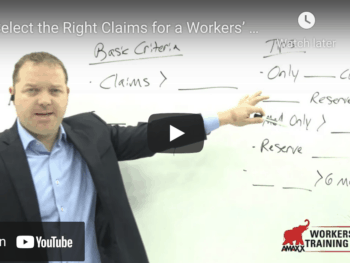
Each of the items that need to be accomplished should be given a due date and placed on the adjuster’s diary (calendar) for completion. You should see at minimum the date due and the date completed for each of the items in the adjuster’s Action Plan.
Initial Claim Handling Completed Day Claim Received
If your adjuster is following the Best Practices set by most insurers and third party administrators, the initial claim handling was completed the day the claim was received in the claims office. You should see file notes reflecting coverage was verified for the claim, that the employer contact, employee contact and physician contact was completed and the initial reserves were placed on the file.
All of these items should have been completed before the adjuster does the initial Action Plan. If for any reason coverage has not been verified, contacts not completed or the reserving cannot be done, the adjuster’s Action Plan should reflect the item(s) that are outstanding from the initial handling and provide the due date for the follow up on those items to be completed.
Click Link to Access Free PDF Download
“Workers’ Comp Claims Review Checklist: 9 Must-Have, Serious-Impact Elements”
Assuming the first day’s claim handling was completed, the initial Action Plan for the work comp claim should contain:
- A follow up date for further contact with the employee (ability to return to work).
- A follow up date for further contact with the employer (availability of a modified duty position if the employee is unable to return to full duty).
- A follow up date to verify the receipt of the initial medical report.
- A follow up date to verify the receipt of the documentation of the average weekly wage (should be within 14 days or less depending on the jurisdiction—in order for the adjuster to issue the first TTD payment or issue a denial of claim).
- A follow up date to complete any further investigation of the claim (should be within 14 days of the date the claim was received).
- If subrogation is appropriate based on the investigation, a date to put the responsible party on notice of the subrogation claim.
- A date to verify the claim is accepted for compensability or the date the claim will be denied.
- A date for the TTD benefit payments to be calculated and the first TTD check issued, if applicable.
- A date for the completion of the ISO filing (within 14 days of the receipt of the claim).
- A follow up date to verify all state required forms have been filed with the state work comp board.
- If the file is reportable to an insurer, excess carrier or any other party, the date the reporting will be completed.
- A date for the next Action Plan to be completed (usually 30 days after the first Action Plan but the time frame can be shorter or longer depending on the severity of the claim).
Second Action Plan Checklist
By the time the second Action Plan is due, most or all of the items outlined in the first Action Plan were completed. Any items not completed are carried over to the second Action Plan with a new due date for each carried over item. Activities you can expect to see on the second Action Plan include:
- A date for reevaluation of the file reserves (usually 60 days from the date the claim was received in the claims office).
- A date for evaluation of the need for a Nurse Case Manager on the claim, if the employee has not returned to work, and assignment of the Nurse Case Manager, if needed.
- A date for coordination of the return to work full duty or modified duty, if needed.
- A date for the obtainment and evaluation of the disability rating.
- If the file is reportable to an insurer, excess carrier or any other party, the date the second report will be completed.
- A date for the next Action Plan to be completed (usually 30 days after the second Action Plan but the time frame can be shorter or longer depending on the severity of the claim).
Third & Subsequent Action Plan(s) Checklist
The third and subsequent adjuster’s Action Plans will vary more in the items that will be included in the Action Plan. Some things to look for in the subsequent Action Plans including their due dates, are:
- Medical records being obtained and evaluated for all on-going treatment.
- Regular scheduled follow-ups with the employee, the employer and the medical providers.
- Regular scheduled contact with the Nurse Case Manager when there is one.
- The completion and filing of all state forms.
- The scheduling and obtaining of independent medical evaluation or a peer review.
- Offsets and deductions being calculated and applied.
- Second Injury Fund (in the jurisdictions that still have one) being placed on notice
- A settlement evaluation that is explained and properly justified, including both the strengths and weaknesses of the claim.
- A Litigation Plan and a Litigation Budget, if the claim is in suit or in a contested board review.
- All required waivers and/or releases obtaines.
- CMS notification if a MSA is considered or needed.
- A re-evaluation of the reserving accuracy.
- Subsequent filing of the claim with the ISO/Index Bureau.
- If the file is reportable to an insurer, excess carrier or any other party, the date the next report will be completed.
- A date for the next Action Plan to be completed (usually 60 or 90 days after the third Action Plan but the time frame can be shorter or longer depending on the severity of the claim).
As long as the work comp claim remains open, the adjuster continues to have an Action Plan outlining the steps to take to bring the claim to a conclusion. The final entry on the adjuster’s last Action Plan for the claim is actually the activity the adjuster looks forward to doing. The final Action Plan activity should read: “Close file.’’

Contact: mstack@reduceyourworkerscomp.com.
Workers’ Comp Roundup Blog: https://blog.reduceyourworkerscomp.com/
©2017 Amaxx LLC. All rights reserved under International Copyright Law.
Do not use this information without independent verification. All state laws vary. You should consult with your insurance broker, attorney, or qualified professional.















